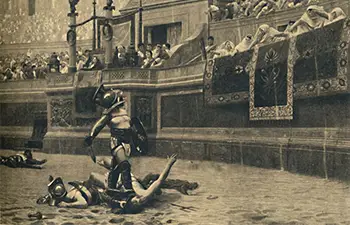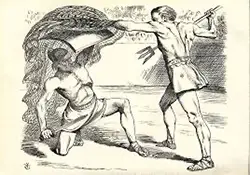The Gladiators of Ancient Rome
The Roman gladiator is one of the fixtures of the images from ancient times that evoke the brutality of the times. Even the most successful gladiator, his life as a fighter a marginal improvement as his life as a prisoner or a slave, lived a short life. 
From the 2nd Century B.C. to the 5th Century, the Roman Republic and then the Roman Empire sponsored public contests between trained fighters as a form of entertainment for the masses. It was the emperor Honorius in 404 who finally abolished such contests, many sources say in conjunction with the martyred protest of a monk named Telemachus. The first recorded fight between gladiators occurred in 264 B.C., and it was more of a commemoration than a crude entertainment. A pair of sons had organized the event in memory of their father, Junius Brutus, who had just died. A century and a half later, the first official gladiator games occurred. One of the most gladiators was one who escaped his training school. Spartacus, along with several dozen other soldiers-in-training, broke the bonds of their Capua ludus (training school) and escaped into the countryside, encouraging other slaves to join them. Their numbers swelled to 70,000 at the height of the rebellion. In the end, a well paid, well equipped very large army of well trained Roman soldiers put down the rebellion, killing Spartacus in the process. Such escapes were rare. The majority of gladiators lived one day to the next, as captured or enslaved individuals who naturally or through training had martial or military skills enough to keep themselves alive while being attacked by another such individual, usually in arena packed with people screaming for bloodshed. 
Especially at the Flavian Amphitheatre (otherwise known as the Colosseum) but also at many other places across the Roman realm, Romans gathered, sometimes in the tens of thousands, to witness spectacles that usually involved violence: animals fighting other animals, humans fighting animals, and re-enactment of battles or famous executions that featured real-life deaths of the participants. The gladiators were the stars of the show, and particularly successful ones could become wealthy and even have families, provided that the fighting didn't cease. As the popularity of gladiatorial combat increased, more and more men volunteered to take part. (Some gladiators are known to have been women; much more prevalent were male gladiators.) A gladiator was typically a prisoner or slave who was sent to a training school and "educated" in the arts of fighting. Life at such a school was marginally better than in a prison or in a slave household, especially with regard to food and medical care: Rich people paid good money to buy or sponsor a gladiator and wanted that fighter to be well fed and medically fit in order justify such an investment. A typical diet for a gladiator was designed to give him (or her) sustained energy and consisted of mainly barley, boiled beans, and dried fruit. The word gladiator itself comes from gladius, a short sword, although gladiators trained with and had specialties in a variety of weapons. They usually as well wore helmets and armor, both of which were routinely decorated. The extent of protection provided by that helmet and armor depended on which class the gladiator belong to: The four principal classes of gladiator were, in order, Samnite, Thracian, Myrmillo, and Retiarius.
 In order to increase the entertainment value, combat organizers often varied the makeup of the combat sessions: At times, two fighters of the same class would face off; in other instances, a gladiator in once class would be in combat with a fighter from another class. Some gladiators fought on horseback; others fought from chariots. Other gladiators known as bestiarii specialized in fighting wild animals; these were rare. In order to increase the entertainment value, combat organizers often varied the makeup of the combat sessions: At times, two fighters of the same class would face off; in other instances, a gladiator in once class would be in combat with a fighter from another class. Some gladiators fought on horseback; others fought from chariots. Other gladiators known as bestiarii specialized in fighting wild animals; these were rare.
A gladiatorial combat was designed to be a fight to the death. If one combatant signaled surrender, such a wish could be granted or overridden, depending on who was in the arena that day. One gladiator who bested another to the point of exhaustion might not want to see that combatant again, for fear of the reverse outcome occurring, and so the victor might decide to dispatch the vanquished. If the emperor happened to be in the stands, then he reserved the right to determine whether such a vanquished but still living gladiator would then receive a death sentence on the spot. (One emperor, Commodus, is known to have taken to the arena himself; dressed as Mercury, he managed to serve all combats in which he took part.) However, it was sometimes the case that both combatants left the arena alive: If they had fought long and hard and put on a good show for the crowd (or if they had bored the crowd so much that the hordes had lost interest), both combatants could be allowed to leave and fight another day. |
|
Social Studies for Kids
copyright 2002–2024
David White




